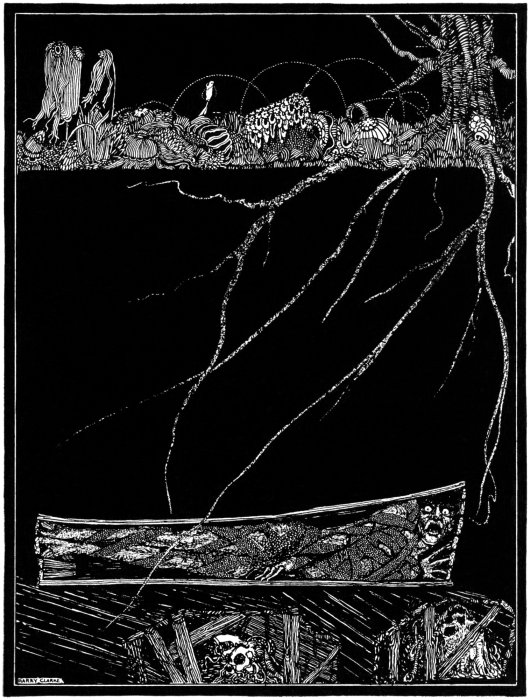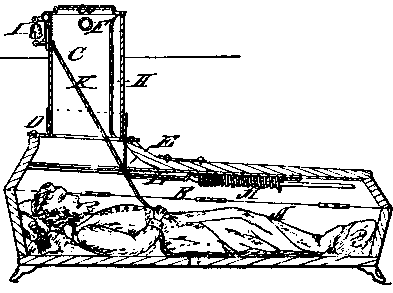Fear of premature burial reaches that primal part in all of us that Sigmund Freud surveyed in his 1919 essay, ‘The Uncanny’. Edgar Allan Poe explored the horrors of premature burial in his 1844 story, ‘The Premature Burial‘. Stephen King even skirted the edges of the fear with his short story, ‘Autopsy Room Four’. In it, a man wakes up to find himself conscious but paralysed on the autopsy table.

The fear is referred to as taphephobia, of ‘fear of graves’. It seems the fears were well founded. In 1905, burial reformer William Tebb claimed he’d collected accounts of 219 cases of near live burial, 149 cases of actual live burial, 10 cases of live dissection, and 2 cases of awakening during embalming (Quigley 2005).
But was premature burial really that common? Or was it just an urban legend that got out of control? Let’s find out in this week’s blog post and podcast episode!
The Medical Side of Premature Burial
Prior to modern medical technology, doctors relied on basic methods to confirm the presence of life. They;
- watched for breathing
- listened for a heartbeat
- felt for a pulse and
- even used the ‘sniff test’ to smell for decomposition.
The invention of the stethoscope in 1816 gave doctors a slightly more accurate way to monitor the heartbeat.
Richard Joltes also notes the dual purpose of “laying out” the corpse (2012). It gave the family time to make preparations, but it also allowed them to watch for signs of life. Even in the early 20th century, news stories describe people regaining consciousness during the funeral, or at the wake.
In earlier centuries, undertakers re-used burial plots or crypts after a passage of time. Charnel houses stored the disinterred remains. According to the legends, some of these corpses had broken fingers, torn lips and horrified expressions. People jumped to conclusions and assumed the dead were buried alive.
Premature burial and folklore
I’ve found plenty of stories of ‘corpses’ being revived when their coffins are dropped. Some regain consciousness during the process of embalming or even dissection!
Franz Hartmann even suggests in his 1896 pamphlet Buried Alive: An examination into the occult causes of apparent death, trance and catalepsy that the phenomenon partially explained vampires. He cites cases in which exhumed bodies bore bloody lips, most likely from bite marks. Paul Barber refutes this, saying “there is simply no evidence that starving people chew on themselves to assuage their hunger” (1990: 99).

Jörgen Hartogs tells a story about a wealthy lady who died sometime around 1849 in New York (2015). Her husband decreed she would be buried in her finery. More importantly, there would be no autopsy. The undertaker decided to remove her jewellery prior to burial, and while taking off her diamond ring, managed to tear the skin. The pain was enough to rouse the woman, and the undertaker naturally fled. She regained consciousness and returned home. According to the post, she went on to have children, so the experience didn’t leave her too worse for wear.
I’ve actually heard a version of this story before, on ghost story tours in the City of London, Edinburgh and York. Every time I hear it, the tour guide insists it’s absolutely true.
Versions of the story exist throughout Europe during the 14th to the 19th centuries – and clearly in the United States too. The main plot is the same, although some details vary. In some versions, the grave robber dies of fright. In other versions, the woman has to walk incredibly far to return home. Sometimes her husband or servants think she is a ghost and bar the woman from her own home.
Lived Once, Buried Twice
One of these ‘Lady and the Ring’ stories relates to a Margorie McCall in Lurgan, Ireland. In 1705, she died of a fever and a swift burial followed to prevent the infection spreading. A grave robber broke into her grave to steal her expensive ring. His efforts revived Margorie, and she went home after the robber fled. According to the legend, her husband John dropped dead of shock when he answered the door.
Margorie McCall really did live in Lurgan, but no evidence exists to prove the story. Despite that, a local stone mason created his own memorial in the 1860s. The stone reads, “Margorie McCall – Lived Once, Buried Twice”. He added it to the headstone of a John McCall in the town cemetery, though there’s no way of knowing if it’s the same John McCall that died of fright!

Premature burial and narcolepsy
Jacqueline Simpson tells a premature burial tale from Sussex. A tombstone in the Rye churchyard features a woman sat upright in a coffin. According to the legend, the lady in question was narcoleptic. One of her episodes lasted so long that doctors pronounced her dead.
Her family laid the coffin in a room at the old Flushing Inn. Luckily the rising warmth from the kitchen below roused her. Naturally, everyone got rather a shock when she appeared downstairs. Her biggest complaint was about being cold. Simpson notes the carving more likely relates to the resurrection of the dead on Judgment Day. Yet “this was misinterpreted by later generations as a warning about the risk of premature burial” (Simpson 2013).
Precautions against premature burial
The British medical community ridiculed Franz Hartmann’s 1896 pamphlet Buried Alive. They considered Hartmann’s comments to be ludicrous at best and it’s hardly surprising. Hartmann even asserted that even putrefaction didn’t guarantee that a person was dead.
Despite that, the London Association for the Prevention of Premature Burial (LAPPB) formed in 1896. Germany introduced waiting mortuaries to monitor corpses for signs of life. Strings tied to corpses would ring bells if the corpse moved.

The Cemetery Bell
One of the more famous inventions following the fears was the cemetery bell. These were bells attached to the side of a grave, with the cord stretching down into the coffin. If someone woke up inside the coffin, they could pull the cord and ring for help.
Some believed the sayings “Saved by the bell” and “Dead ringer” relate to these bells. Sadly, David Wilton debunked the theories, which is a shame because they make a nice story!
Saved by the bell is actually boxing slang, while dead ringer originally comes from horse racing. The ‘ringer’ point came from those horses that passed for other horses in a race. ‘Dead’ was added in the context of ‘dead on’, or ‘spot on’ (Wilton 2004: 77).
Another type of safety coffin allowed anyone buried prematurely to pull a cord, waving a flag above their grave.

I really hope no one did this in a windy cemetery.
Hand wheels fitted inside surface crypts allowed anyone buried alive to open the door and climb back out.
Some people left instructions in their wills that doctors should take steps after their death to avoid premature burial. For example, they might sever the arteries in their neck. Elsewhere physicians might press red hot pokers against the feet, push needles under the nails or burn the skin. Anything to determine if the corpse was, in fact, a corpse!
I actually wrote a story, inspired by such grave bells, which you can find here.
Premature burial in the 21st century
Thankfully, premature burial is unlikely nowadays since better technology makes it easier to pronounce death, even if definitions of death have shifted. That said, authorities discovered a live occupant in a body bag in Massachusetts in 2005.
In 2014, a private hospital in Thessaloniki, Greece declared a woman dead and buried her. Children playing near the cemetery heard her screams and alerted police. You can find the news story here. A second woman in Thessaloniki, Greece suffered a similar fate in 2015. This time, her cancer medicine caused the death declaration. She actually died of heart failure inside her coffin.
We’ll never know how common premature burial was in earlier times. With the lack of medical advances, it may have been more common than we’d like to think.
But it’s hard to find evidence that anyone ever used the features of the safety coffins. The ‘Lady and the Ring’ stories might indicate a whole swathe of women ‘waking up’ after death – but the similarity of the stories, despite their appearance in different locations, has more in common with the urban legend. Especially since none of the stories are backed by documentary evidence.
While stories do occasionally surface about someone being buried alive, I think it’s probably more of a human fear than a real possibility.
Though it does make the thought of cremation even more terrifying…
Sign up below and get my 5-step guide to protecting your home with folklore.
References
ABC News (2006), ‘Body-bagged Woman Still Alive’, ABC News, available here.
Barber, Paul (1990), Vampires, Burial, and Death: Folklore and Reality, New Haven, CT: Yale University Press.
Hartogs, Jörgen (2015), ‘Mistakes Were Made A guide to avoiding premature burial’, History, Archaeology, Folklore and so on, available here.
Joltes, Richard (2012), ‘Premature Burial and the Modern Age’, Critical Enquiry, available here.
Simpson, Jacqueline (2013), Folklore of Sussex, Stroud: The History Press.
Quigley, Christine (2005), The Corpse: A History, Jefferson, NC: McFarland.
Wilton, David (2004), Word Myths: Debunking Linguistic Urban Legends, Oxford: Oxford University Press.
Nutty about folklore and want more?
Add your email below and get these posts in your inbox every week.
You'll also get my 5-step guide to protecting your home using folklore!








Well W.O.W. This was crazy fascinating. I am sure I’ve heard of this as a thing but I can’t recall when so maybe I haven’t. What a concept. Bloody frightening! I wrote a piece of flash about this once! Someone trapped in a coffin in a cremation chamber. But had no idea it was a ‘thing’
What do you think? Do you think any of these occurrences actually happened?
The most recent ones did, but I don’t know how much the fear in earlier centuries was just a panic, and how much was an urban legend! The newspaper stories always talk to a friend who knew someone, rather than anyone directly related to someone who’d suffered.
Great stuff! As Sacha said, ‘crazy fascinating’. I really understand that phobia ~ imagine being in a coma before people know what comas were…. and then there are the various films that have people buried alive – wasn’t Jack Bauer once in a coffin, in 24, or have I just imagined that???
That sounds like the kind of thing they’d do in 24! Then there was the Kill Bill segment where the Bride had to dig her way out! Horrible way to go though.
Glad you enjoyed my article on the topic. I used a lot of material from British Medical Journals of the latter 19th century for the background. The effect basic knowledge of electricity, and the discovery of ether and chloroform as having the ability to render people insensate, were major contributing factors to the changing attitude toward death in this era — largely obsolete words like ‘syncope,’ ‘trance,’ and ‘suspended animation’ were coined during this era to describe various theoretical states!
Hi Icy, this subject is fascinating and terrifying, right? How about you cover necromancy? I’d alsi be interested in exorcism!
I have covered necromancy before – you can find the article here. But I won’t be covering exorcism due to it being a religious process that’s still practiced – it doesn’t fall under folklore or myth, unfortunately.
My wife was born prematurely. Her mother haemorrhaged and nearly died. The baby – clearly dead – was put to one side while the medical staff concentrated on saving the mother. The theatre sister took the body to be disposed off, but thought to check for breathe to be on the safe side.
I have this story from my wife, who was given it as true.